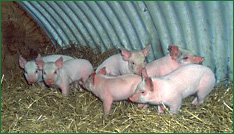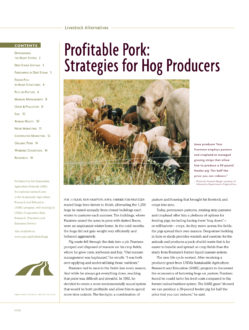
When Swedish regulators imposed stricter animal welfare laws, banned sub-therapeutic antibiotics for livestock and passed other environmental protection laws in the late 1980s, hog farmers pulled pigs out of confinement crates and into group settings. By providing deep straw bedding for groups of pigs, Swedish farmers turned manure into a solid waste, provided warmth and exercise and created an opportunity for the animals to develop natural herd and social instincts that they say promotes better animal health and less piglet mortality.
Many alternative hog systems rely on deep straw. Mixed with the hogs' urine and manure, the deep straw bedding composts in hoop structures. In addition to providing heat, deep straw systems center on hogs growing in groups and allow the pigs freedom of movement.
While much less capital-intensive than confinement swine systems, alternative systems relying on deep straw require careful farm management to minimize disease and provide the feed and bedding hogs need at different stages of life. In economist parlance, raising pigs in these systems means more variable costs - feed, bedding, labor - versus fixed costs such as confinement buildings. Alternative swine researchers like to point out that such systems provide flexibility and less up-front investment.
While the systems are gaining in popularity, especially in England and Sweden, their use in the United States is still clustered in the Midwest, particularly Iowa and Minnesota. Raising hogs in deep straw can be accomplished virtually anywhere because it keeps hogs warm in cold climates. (It's easier to keep hogs warm than cool because hogs only sweat through their noses and have difficulty losing body heat.)
"Alternative swine production systems allow more freedom of movement and choice to the pig and require a unique style of husbandry," said Honeyman. In 1995, Honeyman won a SARE grant to explore the feasibility of importing Swedish systems here and hosted a group of visiting Swedish researchers, farm advisers and farmers for 10 days.
Farrowing in Deep Straw
Some farmers use deep straw for farrowing piglets. Researchers have found that providing individual pens with straw for farrowing sows - but larger rooms with straw for group gestation and lactation - reduces stress by giving the pigs and sows something to root through. Sows on deep-bedded systems are always group-housed, which helps encourage them to go into heat simultaneously.
Hog farmer Dwight Ault's decision to move from a confinement system to deep straw for farrowing was a financial necessity. The Austin, Minn., farmer had 26-year-old crates, gates and other confinement materials badly in need of an upgrade. Aided by a SARE producer grant, Ault decided to emulate a system he had seen firsthand in Sweden and converted a barn for deep-straw farrowing. The work cost $3,000, less than one-third the cost of replacing the confinement equipment.
"I was sick and tired of the ammonia and smell" in the old confinement system, he said. "I figured that my enjoyment of raising hogs would be enhanced."
Today, Ault farrows 60 sows in the deep-bedded system each January, then on pasture each June. After his second season using deep-straw farrowing, in 1998, Ault declared he "never had better performance" from the pigs. "If anything, I'm worried that [production is] going to be way ahead of schedule," he said.
Deep-bedded farrowing requires a room large enough to house about 10 farrowing sows. Providing temporary farrowing boxes in the nursing rooms enables the sows to build straw nests in which they give birth. Piglets stay in the boxes for up to 10 days before farmers remove the boxes and encourage them to mingle with the group.
In the winter, the heat generated by the sows and the composting straw means farmers do not need to provide as much supplemental heat. Large windows and doors allow air to flow, and ventilation systems draw fresh air. The quiet ventilation system allows the sows and piglets to better communicate, which may reduce pig deaths by crushing.
In general, the Swedish farrowing system requires more management, observation and planning than a conventional system, but labor averages only about 18 hours per sow per year. Sow culling rates, building repairs, cleaning, moving, medicating and assistance at farrowing are lower in the Swedish system. However, piglet mortality can be higher in the Swedish system compared to conventional farrowing crates.
When Farrowing in Deep Straw:
- Use enough straw (usually two large round bales) to insulate the pigs from cold cement or ground to start a nursing room of eight to 10 sows.
- Add a bale per week, plus more as needed.
- Allow 27 square feet per sow and 81 square feet per sow and litter.
- Be vigilant about cleanliness to prevent disease.
